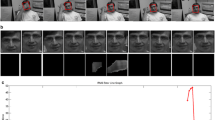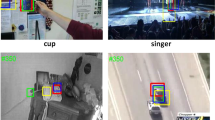Abstract
To recover motion and shape matrices from a matrix of tracking feature points on a rigid object under orthography, we can do low-rank matrix approximation of the tracking matrix with its each column minus the row mean vector of the matrix. To obtain the row mean vector, usually 4-rank matrix approximation is used to recover the missing entries. Then, 3-rank matrix approximation is used to recover the shape and motion. Obviously, the procedure is not convenient. In this paper, we build a cost function which calculates the shape matrix, motion matrix as well as the row mean vector at the same time. The function is in L 1 norm, and is not smooth everywhere. To optimize the function, a continuous-time dynamic system is newly proposed. With time going on, the product of the shape and rotation matrices becomes closer and closer, in L 1-norm sense, to the tracking matrix with each its column minus the mean vector. A parameter is implanted into the system for improving the calculating efficiency, and the influence of the parameter on approximation accuracy and computational efficiency are theoretically studied and experimentally confirmed. The experimental results on a large number of synthetic data and a real application of structure from motion demonstrate the effectiveness and efficiency of the proposed method. The proposed system is also applicable to general low-rank matrix approximation in L 1 norm, and this is also experimentally demonstrated.







Similar content being viewed by others
Notes
When neglecting outliers, we have \(\mathbf {Y}=\mathbf{P}_{m\times3}\mathbf{Q}_{3\times n}+(1)_{m\times 1}\mathbf{U}_{1 \times n}= [\mathbf{P}_{m\times3}, (1)_{m\times 1} ] [\mathbf{Q}_{3\times n}^{T},\mathbf{U}_{1 \times n}^{T} ]^{T}\).
References
Tomasi, C., Kanade, T.: Shape and motion from image streams under orthography: a factorization method. Int. J. Comput. Vis. 9, 137–154 (1992)
Wang, G., Wu, Q.M.J.: Stratification approach for 3-D Euclidean reconstruction of nonrigid objects from uncalibrated image sequences. IEEE Trans. Syst. Man Cybern., Part B, Cybern. 38, 90–101 (2008)
Torresani, L., Hertzmann, A., Bregler, C.: Nonrigid structure-from-motion: estimating shape and motion with hierarchical priors. IEEE Trans. Pattern Anal. Mach. Intell. 30, 878–892 (2008)
Peng, Y., Ganesh, A., Wright, J., Ma, Y.: RASL: robust alignment by sparse and low-rank decomposition for linearly correlated images. In: 2010 IEEE Conference on Computer Vision and Pattern Recognition (CVPR), pp. 700–763 (2010)
Wright, J., Ganesh, A., Rao, S., Peng, Y., Ma, Y.: Robust principal component analysis: exact recovery of corrupted low-rank matrices via convex optimization. In: Bengio, Y., Schuurmans, D., Lafferty, J., Williams, C.K.I., Culotta, A. (eds.) Advances in Neural Information Processing Systems, pp. 2080–2088 (2009)
Liu, Y., You, Z., Cao, L.: A novel and quick SVM-based multi-class classifier. Pattern Recognit. 39, 2258–2264 (2006)
Liu, Y., Sam Ge, S., Li, C., You, Z.: k-NS: a classifier by the distance to the nearest subspace. IEEE Trans. Neural Netw. 22(8), 1256–1268 (2011)
Morita, T., Kanade, T.: A sequential factorization method for recovering shape and motion from image streams. IEEE Trans. Pattern Anal. Mach. Intell. 19, 858–867 (1997)
Hartley, R., Schaffalitzky, F.: Power factorization: 3D reconstruction with missing or uncertain data. In: Australia-Japan Advanced Workshop on Computer Vision, pp. 1–9 (2003)
Buchanan, A.M., Fitzgibbon, A.W.: Damped newton algorithms for matrix factorization with missing data. In: IEEE Computer Society Conference on Computer Vision and Pattern Recognition (CVPR 2005), vol. 2, pp. 316–322 (2005)
Morgan, A.B.: Investigation into matrix factorization when elements are unknown. Technical report, Visual Geometry Group, Department of Engineering Science, University of Oxford (2004)
Ye, J.: Generalized low rank approximations of matrices. Mach. Learn. 61, 167–191 (2005)
Liu, J., Chen, S., Zhou, Z.-H., Tan, X.: Generalized low-rank approximations of matrices revisited. IEEE Trans. Neural Netw. 21, 621–632 (2010)
Wiberg, T.: Computation of principal components when data are missing. In: Proc. Second Symp. Computational Statistics, Berlin, pp. 229–236 (1976)
Okatani, T., Deguchi, K.: On the Wiberg algorithm for matrix factorization in the presence of missing components. Int. J. Comput. Vis. 72, 329–337 (2007)
Chen, P.: Heteroscedastic low-rank matrix approximation by the Wiberg algorithm. IEEE Trans. Signal Process. 56, 1429–1439 (2008)
Chen, P.: Optimization algorithms on subspaces: revisiting missing data problem in low-rank matrix. Int. J. Comput. Vis. 80(1), 125–142 (2008)
Lin, Z., Chen, M., Wu, L., Ma, Y.: The augmented Lagrange multiplier method for exact recovery of corrupted low-rank matrices, October (2009)
Cai, J.-F., Candés, E.J., Shen, Z.: A singular value thresholding algorithm for matrix completion. SIAM J. Optim. 20, 1956–1982 (2010)
Ke, Q., Kanade, T.: Robust L 1 norm factorization in the presence of outliers and missing data by alternative convex programming. In: 2005 IEEE Conference on Computer Vision and Pattern Recognition (CVPR), vol. 1, pp. 739–746 (2005)
Eriksson, A., van den Hengel, A.: Efficient computation of robust low-rank matrix approximations in the presence of missing data using the L 1 norm. In: 2010 IEEE Conference on Computer Vision and Pattern Recognition (CVPR), pp. 771–778 (2010)
Li, S.Z.: Markov Random Field Modeling in Image Analysis. Springer, Berlin (2001)
Zucker, S.: Differential geometry from the Frenet point of view: boundary detection, stereo, texture and color. In: Paragios, N., Chen, Y., Faugeras, O. (eds.) Handbook of Mathematical Models in Computer Vision, pp. 359–373. Springer, Berlin (2006)
Liu, Y.: Automatic range image registration in the Markov chain. IEEE Trans. Pattern Anal. Mach. Intell. 32, 12–29 (2010)
Weickert, J., SteidI, G., Mrazek, P., Welk, M., Brox, T.: Diffusion filters and wavelets: what can they learn from each other? In: Paragios, N., Chen, Y., Faugeras, O. (eds.) Handbook of Mathematical Models in Computer Vision, pp. 3–17. Springer, Berlin (2006)
Stoykova, E., Alatan, A.A., Benzie, P., Grammalidis, N., Malassiotis, S., Ostermann, J., Piekh, S., Sainov, V., Theobalt, C., Thevar, T., Zabulis, X.: 3-D time-varying scene capture technologiesła survey. IEEE Trans. Circuits Syst. Video Technol. 17, 1568–1586 (2007)
Liu, Y., You, Z., Cao, L.: A functional neural network computing some eigenvalues and eigenvectors of a special real matrix. Neural Netw. 18, 1293–1300 (2005)
Liu, Y., You, Z., Cao, L.: A concise functional neural network computing the largest modulus eigenvalues and their corresponding eigenvectors of a real skew matrix. Theor. Comput. Sci. 367, 273–285 (2006)
Orban, G.A., Janssen, P., Vogels, R.: Extracting 3D structure from disparity. Trends Neurosci. 29(8), 466–473 (2006)
la Torre, F.D., Blackt, M.J.: Robust principal component analysis for computer vision. In: Proceedings of Eighth IEEE International Conference on Computer Vision (ICCV 2001), vol. 1, pp. 362–369 (2001)
El-Melegy, M.T., Al-Ashwal, N.H.: A variational technique for 3D reconstruction from multiple views. In: International Conference on Computer Engineering & Systems (ICCES 07), pp. 38–43 (2007)
Zhong, H., Hung, Y.: Multi-stage 3D reconstruction under circular motion. Image Vis. Comput. 25, 1814–1823 (2007)
Martinec, D., Pajdla, T.: 3D reconstruction by fitting low-rank matrices with missing data. In: IEEE Computer Society Conference on Computer Vision and Pattern Recognition, CVPR 2005, vol. 1, pp. 198–205 (2005)
Keshavan, R.H., Montanari, A., Oh, S.: Matrix completion from a few entries. IEEE Trans. Inf. Theory 56, 2980–2998 (2010)
Toh, K.-C., Yun, S.: An accelerated proximal gradient algorithm for nuclear norm regularized linear least squares problems. Pac. J. Optim. 6, 65–640 (2010)
Khalil, H.K.: Nonlinear Systems, 3rd edn. Prentice Hall, New York (2002)
Acknowledgements
We thank the Editor and Reviewers for time and effort going in reviewing this paper. This work was supported by NSFC under Grants 61173182 and 61179071, and the Applied Basic Research Project (2011JY0124) and the International Cooperation and Exchange Project (2012HH0004) of Sichuan Province.
Author information
Authors and Affiliations
Corresponding author
Appendices
Appendix A: Proof of Proposition 1
Under (4), the vector x(t) changes with time t, and V(x(t)) changes accordingly. To study the variation of V(x(t)) with time t, the upper right Dini derivative ‘D +’ is used, which is the generalization of ordinary derivative and is applicable to continuous functions [36]. Based on (4), we have

where we have applied Dini derivative in (1) to differentiate an absolute function, |g(x)|, that is, \(D^{+}|g(x)|= \operatorname {sgn}(g(x))\dot{g}(x)\). In 2) we have inserted (4).
Equation (6) means that if \(\|\dot{\mathbf{x}}^{T}(t)\|^{2}\neq0\), D + V(x(t))<0 will decease V(x(t)). When \(\|\dot{\mathbf{x}}^{T}(t)\|^{2}=0\), x(t) will keep the same value at time t, and from (6) we can see D + V(x(t))=0, which implies that V(x(t)) attains a local minimal value (not a local maximal value due to the restriction of (6)). Thus, under the control of (4), if x(t) does not change, V(x(t)) is locally optimized. If \(\|\dot{\mathbf{x}}^{T}(t)\|^{2}\) does not converge to zero all the time, we can see V(x(t)) will decrease ceaselessly. As we know, V(x(t))≥0 is lowly bounded, and V(x(t)) cannot decrease forever. Thus finally \(\|\dot{\mathbf{x}}^{T}(t)\|^{2}\) will converge to zero, and accordingly D + V(x(t)) will get to 0 in view of (6). So, with the evolution of (6), V(x(t)) will go to a local minimal value.
Appendix B: Proof of Proposition 2
To address the evolution of V(x(t)) under (5), we need to study the derivative of V(x(t)) with respect to time t when x(t) evolves under (5). Like in the proof of Theorem 1, the Dini derivative is used.

where we have inserted (5) in 1). To discuss the influence of σ, we first study the following relation for σ>0 and x∈R:

Equation (8) indicates that \(\operatorname {sgn}(\sigma x )=\tanh (\sigma x )\) when σ=0 or x=0, otherwise tanh(σx) become closer and closer to \(\operatorname {sgn}(\sigma x )\) when σ|x| becomes larger. From (7) we have

where in (1) and (2) we have used \(\operatorname {sgn}(x )= \operatorname {sgn}(\sigma x )\) for σ≠0 and (8), respectively. In terms of whether f kl (x(t))=0 holds, there are two cases: (i) f kl (x(t))=0, which leaves
and (ii) f kl (x(t))≠0, which decreases \(\frac{2}{ \exp (2\sigma|f_{kl}(\mathbf{x}(t))| )+1}\) with the increase of σ. Combining the two cases, we see that with the increase of σ, the probability, in which D + V(x(t))≤0 holds, will increase. Especially, when σ goes to infinity, D + V(x(t))≤0 holds definitely as

goes to zero in this case.
Appendix C: Proof of Proposition 3
We use reduction ad absurdum to prove Proposition 3. Assume it is right that V(x(t)) will keep on increasing, which means

From (3), we know \(V(\mathbf{x})\triangleq\sum_{i=1}^{m}\sum_{j=1}^{n} |f_{ij}(\mathbf{x})|\). The condition that V(x) keeps on increasing means that there is |f ij (x)| (the corresponding ω ij ≠0) which will keep on increasing, and so are σ|f ij (x)|. The condition that σ|f ij (x)| keeps on increasing will make a time t h available, and at t h we have


Both equations, (10) and (11), are all derived from the assumption that V(x(t)) keeps on increasing, and the contradiction between the both equations implies that the assumption is not right. Thus, V(x(t)) does not keep on increasing. When σ is large enough, in view of Proposition 2, a decrease of V(x(t)) occurs more often than increase, and in addition to what we have proved, V(x(t)) cannot keep on increasing; we can say that V(x(t)) falls, on the whole.
Rights and permissions
About this article
Cite this article
Liu, Y., Cao, L., Liu, C. et al. Recovering shape and motion by a dynamic system for low-rank matrix approximation in L 1 norm. Vis Comput 29, 421–431 (2013). https://doi.org/10.1007/s00371-012-0745-5
Published:
Issue Date:
DOI: https://doi.org/10.1007/s00371-012-0745-5




